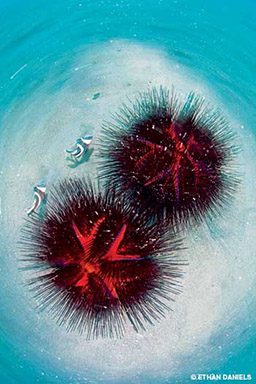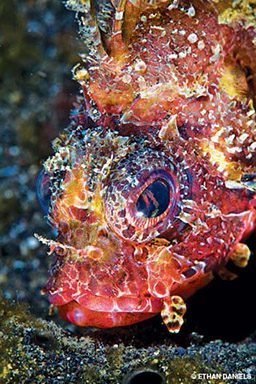Put modestly, the underwater world is diverse. It harbors plant and animal life that runs the gamut from single-celled microorganisms to complex, 90-foot-long vertebrates that feed on prey they can’t see. Marine organisms have descended in continuous lineages that go back 3 billion years, and over that extraordinary period countless species have appeared and then, for one reason or another, petered out, disappearing into oblivion.
The creatures divers observe on today’s coral reefs have sprung from unseen ancestors, many of which we know absolutely nothing about. From sponges to anemonefish, the inhabitants of modern reefs and other marine ecosystems have been selected over many generations. Some organisms are better suited to certain environments, are more capable of acquiring food or have the means to protect themselves just a bit better than others. While underwater, divers observe evolutionary winners in the habitats for which they have been honed.
A Dangerous Place
The ostensible harmony of the marine ecosystems divers enjoy is an utter ruse. From the perspective of any invertebrate or fish, the reef is a ruthless place where competition is fierce, and one can disappear down a gullet in the blink of an eye. Evolutionary pressures come from both the physical environment and from other organisms: predators, prey, competitors and even those linked by mutually beneficial symbiosis. Today’s coral reefs are chock-full of creatures coexisting in a balance that is subtle and built around interdependence and coevolution.
So how did today’s worms, bryozoans, echinoderms, tunicates and fishes “win”? How do sluggish nudibranchs and inert corals outcompete other animals that would take their place if they could? Virtually every part of a creature contributes to its success, and due to a variety of ecological factors, tropical-reef animals have become particularly specialized over many generations, adapting to precise habitats, food types, salinities and other variables. Among the strategies adopted over geologic time (which include speed, strength and size), one of the most effective is the production of potent chemicals that help determine which species are victorious and which are left by the evolutionary wayside.
Enter the Toxin

Over hundreds of millions of years, plants and animals in reef ecosystems have fashioned toxins through random genetic mutations and natural selection. These chemical compounds are used in defensive and predatory tactics including scrambling adversaries’ brain signals, paralyzing muscles, destroying blood cells and digesting tissues from within. The “tranquil” reefs we divers see are anything but. It may be strange to consider while drifting over the lively activity of a healthy reef, but extreme specialization, competition and the need to quickly and quietly subdue prey have guided the evolution of marine toxins. Toxins are products of a complex arms race among organisms that have granted some the ability to outcompete, elude or prey upon others.
A toxin is a biologically produced poison. Venom is a toxin that is administered through a dedicated delivery system — a bite or a sting, for example. When toxins come in contact with living tissue, they may damage or disrupt enzymes, cell receptors or nerve channels. Toxins are highly diverse; University of Hawaii researchers estimate that about 20 million exist in nature. Some may cause only minor pain, while others are quite deadly. Some are relatively simple, and others are startlingly complex; a textile cone snail’s venom, for example, includes dozens of proteins, each targeting a specific nerve channel or receptor.
Toxins are considered secondary metabolites because they are not directly involved in organisms’ growth, development or reproduction but do play a significant role in survivability. David Ginsburg, assistant professor of environmental studies at the University of Southern California, stated, “Secondary metabolites are most common among benthic marine organisms such as invertebrates and seaweeds, which are typically the most abundant reef organisms (as well as the most ecologically significant players), because benthic organisms are vulnerable to the highest rates of attack….” In other words, the slow or immobile creatures that make up so much of the reefs divers enjoy are frequently toxin producers.

Sponges
Sponges are among the most common sedentary animals on reefs. Structural calcium carbonate and siliceous spicules provide nominal protection, but similar to many algae, sponges have evolved a range of secondary metabolites that successfully deter most fish and invertebrates. However, some predators such as angelfish and nudibranchs have adapted to metabolize sponges’ toxins. In fact, nudibranchs have taken the additional step of using their prey’s toxins for their own purposes. Many of these colorful and slow-moving slugs, prized by underwater photographers, dine on sponges, soft corals or tunicates and incorporate those organisms’ poisons into their own tissues. This grants effective defense while allowing the nudibranchs to avoid the need to manufacture resource-intensive toxins.
Cnidarians
All corals have stinging cells, but some (soft corals in particular) have less potent stings than other cnidarians and thus rely heavily on chemical defenses to inhibit predation. Such means also help organisms outcompete rivals for space and other resources. One common manifestation of this is the release of proteins into surrounding water to hamper the growth of nearby species. This is especially important for larval or juvenile coral colonies that would be overrun if not for their secondary metabolites.
Related to corals are the most dangerous animals divers can encounter: box jellyfish. These deadly translucent predators disable small crustaceans and larval fishes immediately upon touching them by unleashing a potent cocktail of neurotoxins, cardiotoxins and myotoxins, causing rapid respiratory and muscular paralysis. The formidable toxins enable the fragile box jelly to avoid injury while capturing prey.
Mollusks
Most divers know that harmless-looking cone shells are best left alone, but their stings are even more wicked than one might guess. There are more than 600 species of cone shell, and each one manufactures its own paralytic neurotoxin that is targeted at specific prey. Researchers from the University of Hawaii estimate that 100,000 toxins are present in cone-snail venoms, which are collectively known as conotoxins.
Some cone shells use their conotoxin-filled, harpoonlike projectiles to kill fish, while other species prey on mollusks or worms. Fish are much faster prey, so it is vital that the toxins of the species that prey on them — e.g., textile and geographic cone shells (Conus spp.) — operate quickly. Anything short of an immediate kill might mean the prey gives up the ghost a few feet away from the snail, and in a coral reef environment that would simply make for an effortless feed by a more mobile competitor. A mysterious aspect of cone-shell biology is the organisms’ apparent ability to alter the compounds in their venom with each injection.
Another critter renowned for deadly venom, which paralyzes and shuts down prey’s respiratory systems, is the blue-ringed octopus (Hapalochlaena spp.). However, blue-ringed octopuses do not formulate their own venom. Instead, a salivary gland near their beaks contains symbiotic bacteria that produce maculotoxin (MTX) and hapalotoxin. With no apparent effect on crabs, a favorite food, MTX is most likely used for defense. MTX may also be used as a predatory inhibitor in the octopuses’ eggs. The octopus releases hapalotoxin into the surrounding water when it’s in the vicinity of crabs. This allows the octopus to easily dismember and consume paralyzed crabs without significant risk.
Fish
A study by the American Museum of Natural History (AMNH) in 2006 estimated that there are more than 2,000 species of venomous fish. Some produce venom themselves, and others have symbiotic relationships with toxin-generating bacteria. Stonefish (Synanceia spp.) are a classic example of venomous fish that produce neurotoxins capable of causing pain sufficient to deter predators. William Leo Smith of AMNH declared, “We don’t know when stonefish evolved, but something really horrendous must have been out there to make these 2-foot-long things develop such a strong toxin….”

Pufferfish, porcupinefish, mandarinfish, rabbitfish, fang-tooth blennies, catfish and stingrays all produce defensive toxins, some of which are lethal, and all of which are compelling deterrents to assailants. As these proteins developed and mutated, the production of ever-stronger venoms became important elements of increasing survivability for many fish, especially during juvenile phases. These valuable chemical defense systems have even led to the evolution of a variety of mimic species. These organisms use predators’ recognition of the venomous fish or invertebrates to avoid predation without having to invest resources in toxin production.
Predators, prey and competitors have battled for eons, and their interactions continually shape marine ecosystems. The evolutionary pressures that go with life underwater have over time introduced and intensified chemical warfare. Toxins unquestionably level the playing field for creatures that evolved without bones, armor, spines or even the ability to move. Through the long and random history of the ever-growing tree of life, chemicals have come to play a common and vital role in the survival of many, if not most, reef species.
Toxins may also prove critical in human endeavors. Ginsburg acknowledged, “…[T]he study of marine secondary metabolites is important not only to gain a better understanding of the ecological functioning and community structure of the natural environment but also to further expand the many ecosystem services (including pharmaceuticals, food products and more) that marine natural products afford us.” Regardless of their specific form, function or origin, toxins and venoms have proven to be essential components of healthy, albeit poisonous, reefs.
© Alert Diver — Q1 Winter 2013